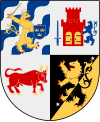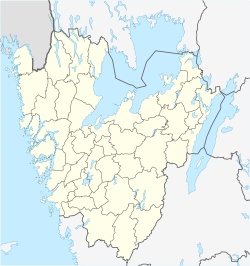Västra Götaland County
Västra Götaland County (Swedish: Västra Götalands län) is a county or län on the western coast of Sweden.
The county is the second most populous of Sweden's counties and it comprises 49 municipalities (kommuner). Its population of 1,616,000 amounts to 17% of Sweden's population.[needs update] The formal capital and seat of the governor of Västra Götaland County is Gothenburg. The political capital and seat of the Västra Götaland Regional Council is Vänersborg.
The county was established on 1 January 1998, when Älvsborg County, Gothenburg and Bohus County and Skaraborg County were merged.
Provinces
[edit]Sweden's counties are generally of greater importance than its provinces. The counties are the main administrative units for politics and population census counts.
Due to its size and young age, the Västra Götaland County has no common heritage. Of cultural and historical significance are the provinces that Västra Götaland County consists of: Västergötland, Bohuslän and Dalsland. There is also an insignificant part of the province Halland within the county.
In addition, the previous counties that were abolished in 1998 had been in use since the 17th century, and therefore have some cultural and historical significance.[citation needed]
Neighbours
[edit]Västra Götaland County borders to the counties of Värmland, Örebro, Östergötland, Jönköping and Halland. It is also bounded by the Norwegian county of Østfold both with a land and maritime border, lakes Vättern and Vänern, as well as the strait of Skagerrak.
Administration
[edit]Västra Götaland was created in 1998 by a merger of the three former counties of Gothenburg and Bohus County, Älvsborg County and Skaraborg County. The seat of residence for the Governors or Landshövding is Gothenburg, while the seat of political administration and power is Vänersborg. The Governor is the head of the County Administrative Board or Länsstyrelse.
Politics
[edit]The Västra Götaland Regional Council or Västra Götalandsregionen is an evolved County Council that for a trial period has assumed certain tasks from the County Administrative Board. Similar trial councils are applied for Skåne County and Gotland County.
Municipalities
[edit]
- Ale
- Alingsås
- Bengtsfors
- Bollebygd
- Borås
- Dals-Ed
- Essunga
- Falköping
- Färgelanda
- Grästorp
- Gullspång
- Götene
- Gothenburg
- Herrljunga
- Hjo
- Härryda
- Karlsborg
- Kungälv
- Lerum
- Lidköping
- Lilla Edet
- Lysekil
- Mariestad
- Mark
- Mellerud
- Munkedal
- Mölndal
- Orust
- Partille
- Skara
- Skövde
- Sotenäs
- Stenungsund
- Strömstad
- Svenljunga
- Tanum
- Tibro
- Tidaholm
- Tjörn
- Tranemo
- Trollhättan
- Töreboda
- Uddevalla
- Ulricehamn
- Vara
- Vårgårda
- Vänersborg
- Åmål
- Öckerö
Heraldry
[edit]The arms for the County of Västra Götaland were granted in 1998 when the county was formed. They are a combination of the provincial arms of Västergötland, Bohuslän and Dalsland and the arms of the city of Gothenburg. When the arms are shown with a royal crown they represent the County Administrative Board, which is the regional presence of (royal) government authority. Blazon: "Quartered, I. the arms of Gothenburg II. the arms of Bohuslän III. the arms of Dalsland turned in courtoisie, IV. the arms of Västergötland."
References
[edit]- ^ "Folkmängd i riket, län och kommuner 31 december 2023 och befolkningsförändringar 2023". Statistics Sweden. 31 December 2023. Retrieved 2 June 2024.
- ^ Regions and Cities > Regional Statistics > Regional Economy > Regional GDP per Capita, OECD.Stats. Accessed on 16 November 2018.
See also
[edit]External links
[edit]- Region Västra Götaland
- Västra Götaland County Administrative Board
- Gothenburg Regional Association of Local Authorities Archived 22 February 2009 at the Wayback Machine
- Sjuhärad Regional Association of Local Authorities
- Skaraborg Regional Association of Local Authorities
- Fyrbodals Regional Association of Local Authorities






